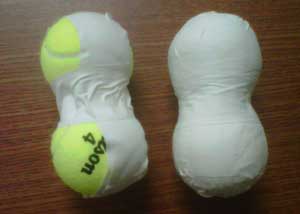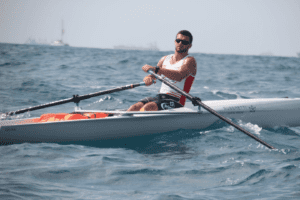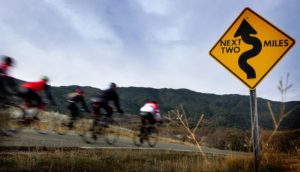This series looks at the areas which can supplement your training to maximise your performance and show you how you can be your own support team.
3: Physiotherapy
In this article we look at how rowers can use simple DIY massage techniques for soft tissue therapy, reducing muscle soreness and avoiding future muscle damage.
What is Soft Tissue Therapy?
Most elite athletes will have regular soft tissue therapy through sports massage.
Soft tissue therapy (STT) is the assessment, treatment and management of soft tissue injury, pain and dysfunction primarily of the neuromusculoskeletal system.
–Wikipedia
Soft tissue therapy is mostly used to ease general muscle soreness caused by heavy training sessions, improve restricted movement and to treat specific injuries or potential injuries related to soft tissue damage. There are various techniques which can be used depending on the type of damage and the area affected.
How can rowers benefit from Soft Tissue Therapy?
Due to the demands of the sport, rowing training programmes work on development of fitness and strength side-by-side. Repetition of movement and a combination of rowing and resistance training (weight lifting) often leads to rowers experiencing muscle fatigue and soreness. While this is often just seen as an inconvenience which does not necessarily restrict the rower’s ability to train, it can reduce training quality through pain and restricted movement and, over time, lead to injury.
One of the most common causes of general muscle soreness and the feeling of fatigued, heavy muscles is damage to the fascia.
The fascia (or myofascia) is a layer of connective tissue which covers the muscles and bones. The fascia allows the body to move freely by providing support for the body’s structures. Overuse, or trauma from a particularly heavy training session, can result in localised irritation and inflammation of the fascia which can restrict movement and cause soreness. Extended inflammation without treatment causes the fascia to thicken and become restricted in its ability to move freely, eventually leading to scarring of the fascia. When people talk about ‘muscle knots’ they usually are referring to myofascial trigger points; small regions of tightly contracted muscle which restrict their own blood supply and cause long-term damage to muscle.
Soft tissue therapy can be targeted at releasing tension in the fascia and returning it to a relaxed state where it can perform properly and allow a full range of pain-free movement.
Myofascial Release
One of the most popular treatments in soft tissue therapy is Myofascial Release. Myofascial Release is a treatment which aims to relax muscles and the fascia and specifically target myofascial trigger points to break down thickened or scarred tissue.
The treatment combines pressure with slow movement on and around areas of muscle soreness (trigger points). Pressure can be applied with the hands, but often tools are used to provide specific pressure and reduce the load on the physiotherapist’s hands.
For more information see “What is Fascia?” – Jennings Training & Treatment Centre
What Soft Tissue Therapy can Rowers do themselves?
While serious and ongoing injuries should be assessed by a professional, there are a few techniques you can use yourself to treat minor issues such as muscle tightness and soreness.
Self-Myofascial Release:
The good news for rowers is that you can perform your own myofascial release therapy without having to visit a physiotherapist. You don’t even need to buy expensive tools. A simple tennis ball is all you need to get started.
Tennis Ball Self-Massage
Tennis balls are great tools for applying the correct pressure for myofascial release. They are a good size for working on trigger points, firm enough to provide pressure, but soft enough not to risk damage to soft tissue.
Trevor Chisman, professional massage therapist, writes about tennis ball self-massage and provides a video of ‘foot rolling’, the first stage of our massage system for rowers.
-Tennis Ball Self-Massage for Rowers:
Equipment needed: Tennis Ball
Perform this massage series as part of your warm-down after a weights session or a hard water or ergo session to relax the muscles and fascia and get the soft tissue healing process kick-started before your recovery begins. It’s a good way of ending the session as a group (although performing step 6 may raise a few eyebrows from onlookers!)
Key points are to keep the pressure light to begin with and slowly apply more pressure. Pressure will get to the slightly uncomfortable stage but should never become painful. Movements must be slow – the slower the better – to relax the soft tissue and break down thickened areas. If you find a particularly tight area (painful or sore) keep the ball still on that area for about 10 seconds before gradually increasing pressure and making small but slow movements around the affected area.
Work on each stage for about a minute, or until you feel the level of discomfort easing.
1: Feet
Rowers often neglect the muscles in their feet, even though they are important for balance and stability on the footplate.
While standing, put the tennis ball under one of your feet and allow some of your bodyweight to rest on the ball. Gently and slowly roll the ball along the length of your sole and across the arch and ball of your foot. Slowly apply more pressure and increase range of movement (but not the speed of movement). Swap feet and repeat.
2: Calves
Sit on the floor with your legs flat in front of you. Put the tennis ball under the widest part of your calf muscle and let the weight of you leg rest on the ball. Roll it slowly around your calf and along the lower leg towards the ankle, gradually increasing pressure. Avoid contact with the achilles tendon and the back of the knee. Roll your leg to each side to work the edges of the calf and apply pressure to the whole muscle. Swap legs and repeat.
3: Hamstrings
As with the calves, place the tennis ball under the back of your thigh and allow your bodyweight to rest on the ball. You can limit the amount of weight on the ball by keeping some weight on the seat. Move the ball slowly across the whole muscle and its full length, avoiding the back of the knee. Swap legs and repeat.
4: Quads
Put the ball on top of your thigh and apply pressure by pushing down with a flat hand. Roll the ball across your thigh with your hand, applying more pressure as you move. Keep the motion slow. Roll along and across the whole muscle, including the sides of the thigh, but avoid the knee cap. Swap legs and repeat.
5: Glutes
Place the tennis ball under one buttock. This one can be painful so limit the amount of weight on the ball by lifting your weight up off the floor with your hands. Roll the ball across the whole muscle and allow some more weight to rest on the ball. Swap sides and repeat.
6: Hips
Roll over to lay flat on your front. Place the tennis ball at the top of your leg, inside the hip joint. Gently rest some of your body weight on the tennis ball and slowly move it underneath you, around the hip joint. Swap sides and repeat.
7: Back
Lay on your back with knees bent, feet flat on the floor. Place the tennis ball on the strip of muscle which runs either side of the spine. Be careful to make sure that the tennis ball is not in contact with the spine. Slowly and gently allow some body weight to rest on the tennis ball. Gently straighten the legs to roll the tennis ball down your back towards your pelvis; bend your legs to roll it up as far as the shoulder blade. The ball should move straight along the back and not sideways towards the spine or the ribs. Swap sides and repeat.*


*Update: Thanks to Alex Foreman & Jack Williams on Twitter who both reminded me about ‘Tennis Ball Peanuts’ which remove the issue of keeping the tennis ball in place and away from the spine while working on the back. Simply tape two tennis balls together and position each on the muscle, with the spine resting in the gap between.
8: Upper Arm
While sitting, hold the tennis ball in your hand and roll it slowly along your bicep and tricep. Swap arms and repeat.
9: Lower Arm
Place the tennis ball on the floor and slowly roll it under the inside of your lower arm, from elbow to wrist. Rest more weight onto the ball to increase pressure. Swap arms and repeat.
-Foam Roller Self-Massage for Rowers:
Similar to the Tennis Ball massage, rowers can benefit from using a foam roller to apply less targeted pressure for more general myofascial release. Foam rollers can be purchased from many sports shops or physio supply shops. Get one which is at least 50cm long so that it will allow you to apply pressure to both legs or across your whole back.
This article from sport-fitness-advisor.com shows leg, hip and back exercises using a foam roller and provides animated pictures to demonstrate the movements.
The hamstring exercise can be performed on both legs simultaneously to start, but more pressure will be available with the roller under one leg at a time.
Build some soft tissue therapy into your warm-down after a hard session, or as a therapy session in itself if you feel muscle soreness the following day. It may feel uncomfortable to begin with but remember to start with light pressure and slowly increase pressure, always keeping movements slow to help to relax the tissue. You should find that your recovery is accelerated with reduced soreness and increased range of motion, leading to better quality training in subsequent sessions and reduced risk of injury.








